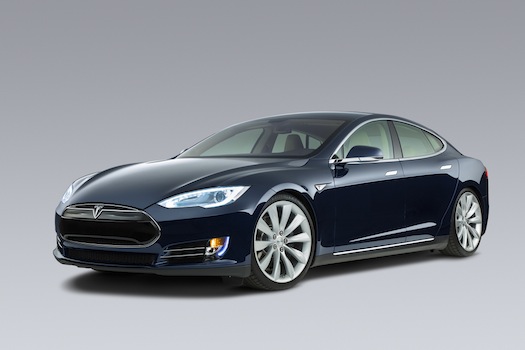

If you were to walk into a Chevrolet dealership today and ask for a Blazer, the salesperson would show you a milquetoast mid-sized medium-priced crossover. Its starting MSRP is $33,400, and you can choose from a two-liter turbocharged inline-four cylinder or a 3.6-liter V6. Either way, you’ll find yourself pumping gasoline. That changes next year when Chevrolet’s new Blazer EV launches.
Chevrolet first teased the Blazer SS EV back in March of this year, and finally showed the world what the performance electric crossover would look like on June 13 when GM CEO Mary Barra tweeted a photo of it. While we don’t yet know the specifications of the vehicle—those will be unveiled in about a month—the car seems promising even without the details. General Motors, and by extension Chevrolet, has a wide variety of electric motors and electric battery stacks to choose from when building this machine, so expect to see at least a few variants.
The one pictured in Barra’s tweet appears to be the upmarket performance “SS” model, which is likely being built to go head-to-head with Ford’s Mustang Mach-E GT. It’s more than likely that this machine will be built on GM’s Ultium battery technology, which it co-developed with Honda. And if GM used the same motors from the all-wheel drive version of the electric Cadillac Lyriq, the Blazer SS EV would have exactly what it needs to fight its Ford and Tesla rivals, putting down about 500 horsepower to the Mach-E GT’s 459 and the Model Y Performance’s 450. Based on what we can infer from the images of the Blazer SS EV, it looks like it could simply be a Lyriq in Chevrolet clothing.
If the Blazer SS EV is in fact Lyriq-based, it will likely undercut both Tesla’s Model Y Performance and Ford’s Mach-E GT on price. Cadillac’s Lyriq AWD is priced at an impressively competitive $64,990, and a lower-content Chevrolet-badged model would likely fall a good bit below that $60,000 mark, which is near exactly where both the Ford and Tesla are priced.
In short, we don’t expect the Blazer SS EV to be a bargain-priced EV, but it’ll almost certainly offer similar performance for less money to the competition, which Chevrolet has a history of doing. Being on the same platform as the Lyriq would also indicate that it’s likely that a base model Blazer EV would be rear-wheel drive and carry about 312 horsepower.
The existing gasoline-powered Blazer crossover appears to share nothing with its future electric counterpart, and this type of branding approach is already in place with Chevrolet’s Silverado EV: The gasoline-powered Silverado is a completely different vehicle than the electric Silverado. The former is built in the tradition of steel ladder-frame pickups, while the Silverado EV is a pickup built on the same quasi-unibody platform as the GMC Hummer EV. As with the Silverado variants, the Blazer EV makes use of more aggressive—and subjectively more attractive—bodywork than its gasoline sibling.
Chevy says the Blazer EV is coming in 2023, and together with the smaller and less-expensive electric Equinox and Bolt EUV, will set the automaker up nicely for the EV future with three different sized electric crossovers. If the Bolt EUV and Equinox EV both start around the $30,000 mark, and the Blazer slots in somewhere in the low-to-mid $50,000 range, Chevrolet could have a handful of hits on its hands. These are the cars that new car buyers want to buy, and making them electric while still hanging on to the affordability that Chevy is known for is a smart play in the current car market.
General Motors has deeper experience building EVs than you might assume: Not only was it responsible for the first mass-market electric car in the EV1 way back in 1996, but it delivered the plug-in hybrid Volt in 2010 and the modern battery-electric Bolt hatchback in 2016. While companies like Nissan and Tesla have built more EVs, GM has been doing it longer.
The new Chevrolet Blazer SS EV is just one of the many new EVs planned to come out of the General Motors stable in the next handful of years. The company announced in 2020 that it would invest $35 billion globally in EV and autonomous vehicle tech through 2025. That included converting the old Hamtramck plant in Detroit into an all-EV facility called Factory Zero.
Add in that the company is rolling out new battery electric models at breakneck speed, and this moment could be the tipping point toward widespread adoption of EVs in America. GM says it wants to sell a million EVs per year in North America and China by the middle of the decade, and it only has a couple years left to make that happen. Buick recently announced it would be going all-electric, GMC already sells the very large Hummer EV, and Cadillac is also pivoting to electric. Between the upcoming electric Corvette, Silverado EV, the Blazer EV, and the Equinox EV, Chevrolet has its EV bases covered.























